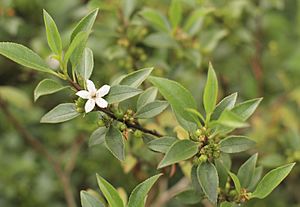Myoporum viscosum facts for kids
Quick facts for kids Sticky boobialla |
|
|---|---|
 |
|
| Scientific classification | |
| Genus: |
Myoporum
|
| Species: |
viscosum
|
| Synonyms | |
|
|
The sticky boobialla (scientific name: Myoporum viscosum) is a unique plant found only in South Australia. It belongs to the figwort family, called Scrophulariaceae. This plant is quite special because its leaves can sometimes have a very unpleasant smell, especially when you crush them.
Contents
What Does It Look Like?
The sticky boobialla is a shrub that can grow up to about 2 metres (6.6 feet) tall. Its young branches are flat and feel sticky.
Leaves
The leaves grow in an alternating pattern along the stem. They are usually between 20 and 52 millimetres (0.79–2.05 inches) long. They are also 7 to 20 millimetres (0.28–0.79 inches) wide. The leaves are thick and stiff. The bottom part of each leaf wraps around the stem. The edges of the leaves are serrated, meaning they have small, saw-like teeth. You can also see many tiny oil dots on them.
Flowers and Fruits
The flowers grow in groups of 5 to 8 in the spots where leaves join the stem. Each flower cluster has a stalk that is 4 to 8 millimetres (0.16–0.31 inches) long. Each flower has 5 triangular sepals, which are like small leaves that protect the bud. It also has 5 petals that join together at their base to form a bell-shaped tube.
The petals are white, sometimes with a light purplish colour and purple spots. The petal tube is 3 to 4 millimetres (0.12–0.16 inches) long. The inside of the tube and the base of the petals are covered in tiny hairs. Sticky boobialla usually flowers from June to November. After the flowers, the plant produces round, purplish fruits called drupes. These fruits are juicy and about 3 to 5 millimetres (0.12–0.20 inches) across.
How It Got Its Name
The sticky boobialla was first officially described in 1810 by a botanist named Robert Brown. He wrote about it in his book Prodromus Florae Novae Hollandiae. He found the first plant sample at Memory Cove.
The second part of its scientific name, viscosum, comes from a Latin word. Viscum means "bird-lime," which is a sticky substance. The ending -osus means "abounding in." So, viscosum means "sticky" or "viscid," which perfectly describes the plant's sticky branches.
Where Does It Grow?
For many years, people sometimes confused the sticky boobialla with another plant called Myoporum petiolatum. However, Myoporum petiolatum has thinner leaves that are not smelly.
The sticky boobialla only grows in a few specific places. You can find it on Kangaroo Island. It also grows along the coastlines of the Eyre and Yorke peninsulas in South Australia.
Why Is It Useful?
The sticky boobialla is a very tough plant. It can handle salt spray, which means it can grow well near the ocean. People sometimes use it as a low plant to create a screen or hedge in gardens.
It is easy to grow new sticky boobialla plants from cuttings. It grows best when it gets lots of sunshine.

